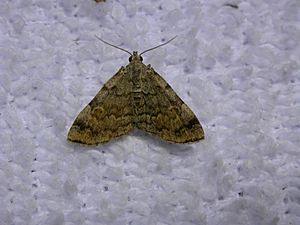American idia facts for kids
Quick facts for kids American idia |
|
|---|---|
 |
|
| Scientific classification | |
| Synonyms | |
|
The Idia americalis, also known as the American idia or American snout, is a type of litter moth. It belongs to the Erebidae family. This moth was first described by Achille Guenée in 1854. You can often find it in damp forests across North America. Its range stretches from southern Canada all the way to Florida and Texas. This moth is active at night, meaning it is nocturnal. People can attract it using sugar baits or special light traps.
Contents
What Does the American Idia Look Like?
The American idia moth has forewings that can be grey, beige, or light brown. These wings get darker near their outer edges. They also have wavy, darker lines that cross the wings. A dark line sits at the very edge of the wing's fringe. All American idia moths have a small bronze or brown spot. This spot is usually found near the edge of the forewing.
The hindwing is a lighter grey than the forewing. It also has darker, wavy lines. Some moths can be very dark grey or brown. The moth's body, including its thorax (chest) and abdomen (belly), is smooth. Its legs, called tibia, do not have hairs.
Female moths have simple antennae. Male moths have antennae that look like tiny combs, called biciliate. Otherwise, male and female moths look very similar.
The Caterpillar Stage
The caterpillar of the American idia is brown. It has dark brown spots and a black head. Small white hairs grow along its sides.
Size and Life Cycle
The American idia moth has a wingspan of about 20 to 30 millimeters. That's about the length of two to three small paperclips! Adult moths are usually seen flying from May to October. They can have two or more groups of babies, called broods, each year.
How to Identify the American Idia
It can be tricky to tell the American idia apart from similar moths. One way is to look for a row of dark marks. These marks are found on the front part of its forewing. Sometimes, people might mistake the American idia for a small Geometer moth.
What Do They Eat?
The larvae (young moths) of the American idia eat lichen and dead plant material. This includes fallen leaves. They also help clean up by eating dead things in ant nests. This makes them detritivores. Adult moths often eat lichens that grow on tree trunks.
Known Host Plants
The American idia moth's larvae and adults feed on several types of plants and fungi. These are called host plants.
- Leguminosae - This is the legume, pea, and bean family.
- Lichenes - These are lichens, which are like a mix of fungus and algae.
- Angelica - A type of plant.
- Pseudotsuga menziesii - The Douglas fir tree.
- Picea - Spruce trees.
See Robinson, G.S. et al.

